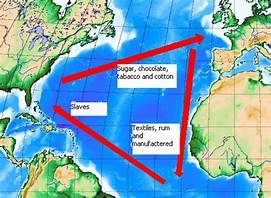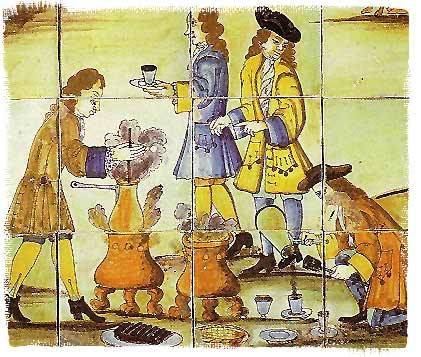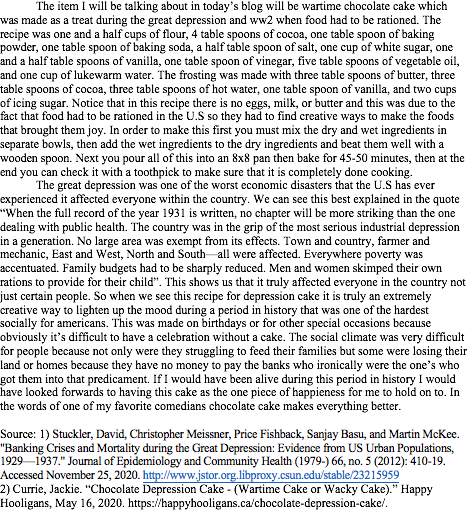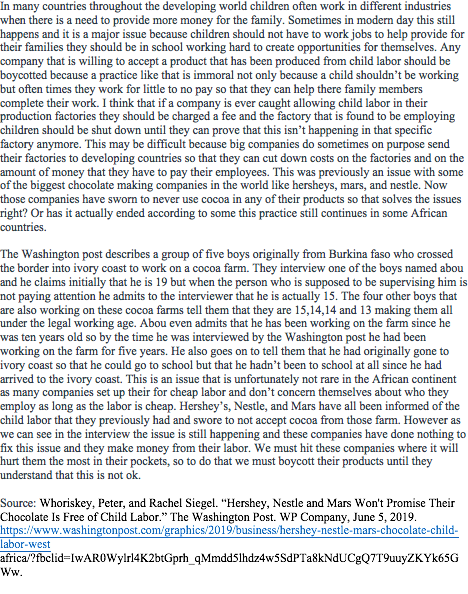murillonick12
8 posts
Don't wanna be here? Send us removal request.
Text
what role did the world fair and trading cards play in chocolate marketing?

In this blog we will talk about how trading cards and the world fair would provide a big boost for chocolate advertising along with the technologies it introduced the chocolate making industry. The need for chocolate booths at these fairs to stand out stemmed from the tough competition there was to get peoples interest quickly so that they would cone to their booth to check out their product. The chocolate companies were not only competing against those in their hall but also those in other halls like science who could get people to come by having their product do something cool and get people talking. During the search for a way to compete trading cards emerged and would become a hit first among people in these halls then among common customers. Eventually this would spread to become something commonly done by chocolate companies. In 1876 the United States hosted the international exhibition of arts where the U.S and other countries presented all the best they had to offer in the sciences, arts and even in food. In this giant hall there was 20 exhibits that focused solely on candy production and these stalls got creative with how they presented their products. While there was many exhibitions of amazing new chocolate and products covered in chocolate the science hall also had plenty of machines that would revolutionize the chocolate making business and makes things easier for so many manufacturing companies. This would lead to many more world fairs throughout the years that would just keep providing new technologies for the chocolate industry allowing them to grow and innovate over the years. In a 1904 edition of the fair guests were able to study raw materials for chocolate under a large glass jar. Some of these materials included cacao pods, beans, shells, cocoa butter, cocoa powder and finished chocolate. Eventually companies would smarten up to the fact that if they gave out samples of their products they could have more people try their chocolate’s and in turn gain more customers. This would become a sort of competition between the various chocolate making companies with each of them trying to one up each other with each passing exhibition fair. As the years passed companies tried to find new ways to market their products and eventually trading cards were created to become collectible items that promoted a chocolate company and would reach so many people as they were meant to be collected and traded.
The man who is given the credit for coming up with the idea of mass producing trading cards is louis prang but only because he had built a reputation for his extraordinary color reproductions. Prang like most lithographers originally produced his own color trading cards to promote his own products for the Vienna international exposition in 1873. In 1876 the centennial exhibition in Philadelphia provided the perfect opportunity for trading cards to blow up during this time. The booths who were participating in the exhibition wanted to provide all of the guests who attended their booths a trading card like paper and those who were at the event decided that they wanted to collect every card that was at the exhibition as a keepsake to have for their own memories of the time that they spent their. This gave people an incentive to visit as many different booths as they could to collect cards and would make chocolate something more than just a snack you eat. Chocolate companies would develop different types of trading cards, there was “showcards” which were meant to be put on display in stores. Then there was grocers cards made to be given out to customers that had colorful artwork on the front and on the back it had information on the product it was given with or some had chocolate prices on the back as well. A whole variety of other cards would be manufactured like manufacturer’s cards and three dimensional cards that were meant to increase business by giving the information of where the store was located and the other was made to be flashy so that everyone could see it and either want it or want to see what’s on it. these trading cards would put an advertisement for chocolate in many houses and would always provide people with a message that they should buy chocolate just by owning or seeing these cards somewhere.
Source: 1) Grivetti, Shapiro, Grivetti, Louis, and Shapiro, Howard-Yana. 2009. Chocolate: History, Culture, and Heritage. Hoboken, N.J.: Wiley.
0 notes
Text
how did chocolate end up in Africa?

In this blog we will talk about the Portuguese and how they had such a huge reliance on slavery to ensure that they had a strong workforce for chocolate manufacturing plants. this reliance would lead them to even make cacao plants in Africa. Thus leading to the first production plant of chocolate on the continent which would lead to Africa eventually becoming one of the most important places for raw chocolate production. We will also talk about how the production of chocolate in brazil worked and where was the best areas of the country to grow and set up these plants for cacao. The Portuguese used Africans and natives to work on the cacao processing plants and do all the physical labor that they needed. Genetic research has established that all cacao originated from the headwaters of the amazon river and if it was grown anywhere else that was done by taking seeds to that area and planting them. The two biggest regions where cacao was grown in brazil was the amazon and bahia. In the amazon it grew naturally as the climate and environment helped it to thrive there and in bahia cacao had to be transplanted and cultivated in plantations because it could not naturally grow there like in the amazon. The Portuguese used Africans and natives to work on the cacao processing plants and do all the physical labor that they needed. After some time, they lost so many native Americans that they had to bring more slaves from Africa and developed a dependency on slaves to do the labor in Brazilian chocolate plants. Many slaves were brought from Portuguese colonies in Africa to provide the physical labor for these plantations. This was done in exchange for cacao, so as cacao was being transported over to Portugal from brazil, there was a constant flow of slaves in brazil that could work. When they started to see that there was an independence movement brewing within their Brazilian colony, they did what they could to transport production to colonies in west Africa. While they did have to adapt the process to the environment within these new countries. The result was not exactly how it was before, but it was producing promising results, like what they were making in Brazil.
As stated in the previous paragraph when Portugal began to see that they were starting to lose some of its control over brazil they decided to find a way to export its cacao production to its other colonies. They couldn’t just let it go away because it made them a lot of money but also, they believed it to be important for their nobles and soldiers because of the health benefits that they believed it possessed. They were able to set up plants in west African colonies and had to send cacao seedlings to these colonies since cacao did not naturally grow in Africa. This helped to maintain a good flow of cacao production and made it so that eventually they could create a large-scale cacao production plant within Africa. Portugal would send over large numbers of slaves to brazil for labor, this is a huge reason why so many Brazilians have darker skin tones. However, the number of slaves they sent of world diminish due to abolition mo9vements springing up in Europe and north America. One of the leaders of this movement was Britain who helped to stop the sending of slaves to colonies not only within their colonies but also to many Portuguese speaking colonies. While they were still able to maintain their pace of production, they previously had it would eventually catch up with them. Through all of this we see that chocolate did bring in many slaves to brazil influencing what the population looks like in current day. While it’s true that slaves probably would have been sent to the Brazilian colony regardless the production of chocolate would leave behind a lasting repercussion that is seen in modern day.
Source: 1) Grivetti, Shapiro, Grivetti, Louis, and Shapiro, Howard-Yana. Chocolate: History, Culture, and Heritage. Hoboken, N.J.: Wiley, 2009.
0 notes
Text
how chocolate conquered Europe.

In this blog we will explore what type of effect did the introduction of chocolate have on the continent of Europe. We will also explore how the Portuguese saw chocolate in a different way than the Spanish when they were introduced to it in their colony of Brazil. It was in 1668 when the first earl of sandwich had recently returned from a trip to Spain, gathered his friends and told them about a new food that they were serving in Spain called chocolate. In his journal the earl details the process of how chocolate is made into various forms including into a drink. In his journal he also talks about the “rules” that there are for consuming the drink and translates the recipes into English so that others could make chocolate. This would be the first written document that translated the recipe for making chocolate into a language that was not Spanish. One of the countries that went into the consumption and sale of chocolate was Netherlands who fell in love with chocolate with many people in Amsterdam selling chocolate straight from their homes. However, the Dutch were not the only ones who were importing, producing and selling chocolate as the French had become interested in it as well. The French had the government form a monopoly over the production and sale of chocolate within the country. This was done to try and make sure this new industry succeeded and -also to try and bring more money into the country. Spain would benefit immensely from all these European countries developing a taste for chocolate and were forced to ramp up production in central and south America to try and keep up. Even though Spain did have control over most of the countries within Latin America they were not the only country with colonies that introduced them to chocolate as Portugal had brazil. When the Portuguese were introduced to chocolate by native Brazilians, they would also benefit from the developing taste for it that was happening in Europe.
When the Portuguese first were introduced to chocolate it was valued more for its medicinal purposes than its taste. It would not be until the eighteenth century where it would be considered a delicacy but even then, it was only served to those who were royalty or nobles of the royal court. In Spain chocolate hit its peak popularity in the 16th century many years before it became a delicacy among Portuguese royals. Something that was a contrast to what the Portuguese believed about chocolate, while they believed it to be a delicacy for the royals and those in the noble court. They also believed that it should be something given to soldiers to help them maintain their health as they were the ones defending the country. This may seem a bit strange because whenever there is an item that is reserved for those in royalty it is not shared with anyone else so the fact that this was given to soldiers because of the medicinal properties was a bit unexpected. Due to this development would the chocolatier in the Portuguese royal household be considered a cook or a healer? It is interesting that this happened because in Spain chocolate was mostly a delicacy that people enjoyed. The medical properties were forgotten about and was only a commercial food. Why do you believe this happened?
Source: 1) Ferry, Robert J. "Encomienda, African Slavery, and Agriculture in Seventeenth-Century Caracas." The Hispanic American Historical Review 61, no. 4 (1981): 609-35. Accessed November 25, 2020. doi:10.2307/2514606.
2) Grivetti, Shapiro, Grivetti, Louis, and Shapiro, Howard-Yana. Chocolate: History, Culture, and Heritage. Hoboken, N.J.: Wiley, 2009.
0 notes
Text
how making chocolate changed

In this blog we will talk about how making chocolate changed as technologies advanced, and how it went from an operation done by common people where they would go into the forest and grab whatever cacao pods they believed were best, to an assembly line type manufacturing plant. We will look at how chocolate was made before they had access to these technologies and how it was made once they had these technologies. We will also compare the processes and see how they were different from each other to show how much faster the process became and how it would evolve once the Spanish came into the Americas. The process to make chocolate has changed and evolved over time, not only in the actual way that chocolate is made but also the recipe to make chocolate or other chocolate flavored items has developed as new technology has become available. With the original recipe the first step was to gather ripe cacao pods from a forest area or if it was available a garden. Next was to cut open the shell that had the “beans”, which was a pod like circle inside the shell, inside of it taking out any pulp that was inside of this shell like structure. In order to give these beans, the chocolatey flavor that we recognize today they had to let the beans ferment for several days if not the desired flavor would not be achieved. After letting them ferment for a few days they were put out into the sun so that they could dry for a week or two, after this the husks were removed from the pod reveling the actual beans. They would then be grounded on a stone metate into a paste like substance, the taste without doing this could be compared to what unsweetened dark chocolate would taste like. Various ingredients would later be added to this paste and what they added depended on what that specific person was hoping to achieve with that drink.
While there is no recorded history of the first ever manufacturing plant of chocolate there is history of people in south America who created chocolate manufacturing plants. In these plants the first step was like how it was originally done, they would roast the “beans” and ground them on stone slabs or metates. The resulting chocolate would then be left to sit until it hardened into a solid mass or would be formed into small cakes or tablets. This process would result in chocolate that produced the same tasting chocolate as before but at a faster speed. Over time though they would develop ways to avoid burning the beans during roasting, along with ways to ground and mix items with the beans to give it distinct flavors. All these techniques together and the improvement of technology would ultimately lead to a faster production of chocolate, and the popularity of manufacturing plants would rise exponentially. When the Spanish arrived and finally discovered chocolate they added some new steps to the process of making chocolate. After they removed the beans from the shells, they put them in a sieve to clean out any dirt, rocks, or broken/ moldy beans. Beans were then shoveled up and put over a non-smoking flame then stirred and dried to loosen the beans from the outer shell. The nibs were then made into liquor and molded into chocolate, over time this process was adapted to suit the advancing technology that the Spaniards had developed. Some of these steps continue to be used in the modern day process that we use to make chocolate those steps including roasting, winnowing, milling and molding. This shows us that even though our technology has evolved and changed over time the original processes will always be useful in the chocolate making process.
Source: 1) Snyder, Rodney, Olsen, Bradley Foliart, and Brindle, Laura Pallas. 2009. “From Stone Metates to Steel Mills.” In Chocolate, 611–23. Hoboken, NJ, USA: John Wiley & Sons, Inc. https://doi.org/10.1002/9780470411315.ch46.
2) Edgar, Blake. "The Power of Chocolate." Archaeology 63, no. 6 (2010): 20-25. Accessed November 22, 2020. http://www.jstor.org/stable/41780626.
0 notes
Text
Origins of cacao

Cacao was a versatile plant for the Mesoamericans that used it and had many different purposes within their society, with it being used for commercial, medicinal, nutritional, and spiritual purposes. While we have found a number of uses that chocolate has had in Mesoamerica there is still so much that is unclear to historians, despite this we have still managed to find some uses that were documented by people alive at the time. In this blog we will talk about how cacao in it’s raw form and in drink form were valued and used in Mesoamerican society. We will also talk about why the chocoltl drink was something reserved for those who were royalty and for the gods. Historians have credited the discovery of cacao beans to the Olmec’s, but they credit the Mayas with cultivating it and helping it become the commodity that it is today. The Mayas would later pass on this knowledge of the cacao bean and its cultivation to the Mexica’s. In Mesoamerica cacao was used for commercial, medicinal, traditional, and spiritual purposes and on some occasions cacao would even be used in artistic pieces. The drink that was made from the cacao bean was considered to be “the food of the gods” showing just how much they valued the cacao bean. Archeologists have found various ceramics, stone carvings and murals that show us the symbolic value that cacao had for the Mesoamerican people. The Aztecs would use cacao beans as a form of currency which made it central to political power in the Aztec empire. Documents were found that gave some prices of objects that people could use cacao to pay for like a turkey which was worth 200 cacao bean while tamales were worth 100. With this we are shown the versatility of the cacao bean as it was valuably in the drink form that royals consumed but the raw bean was also valuable and served many different purpose throughout the Aztec culture. Even though archeologists were able to discover all these uses of the cacao bean in Mesoamerican culture it is still been difficult for historians to understand scope of the history of cacao.
Some historians have even traced mention of cacao to the popol vul, an ancient Mayan book that talked about their society and culture. When we look further into what the popol vul says about it states that the gods used several different foods to create humans and included among them was cacao. So in turn when they learned how to make the chocoltl drinks from cacao it was reserved mainly for royalty who were regarded as godlike figure within their society. There were several steps involved in making the chocolate drink that royals drank during this time. The first step was to gather ripe cacao pods from a forest area or if it was available a garden. Next was to cut open the shell that had the “beans”, which was a pod like circle inside the shell, inside of it taking out any pulp that was inside of this shell like structure. In order to give these beans, the chocolatey flavor that we recognize today they had to let the beans ferment for several days if not the desired flavor would not be achieved. After letting them ferment for a few days they were put out into the sun so that they could dry for a week or two, after this the husks were removed from the pod reveling the actual beans. They would then be grounded on a stone metate into a past like substance, this alone could be compared to what unsweetened dark chocolate would taste like. Various ingredients would later be added to this past and what they added depended on what that specific person was hoping to achieve with that drink. This could include making it for medicinal purposes, or if they simply wanted to enhance the flavor to make it tasty for whoever they may be serving it to.
Source: 1) Edgar, Blake. "The Power of Chocolate." Archaeology 63, no. 6 (2010): 20-25. Accessed November 22, 2020. http://www.jstor.org/stable/41780626.
2) De Orellana, Margarita, Richard Moszka, Timothy Adès, Valentine Tibère, J.M. Hoppan, Philippe Nondedeo, Nezahualcóyotl, Nikita Harwich, Nisao Ogata, Quentin Pope, Fray Toribio De Benavente, Motolinía, Guadalupe M. Santamaría, and Daniel Schechter. "Chocolate: Cultivation and Culture in Pre-Hispanic Mexico." Artes De México, no. 103 (2011): 65-80. Accessed November 22, 2020. http://www.jstor.org/stable/24318969.
4 notes
·
View notes





